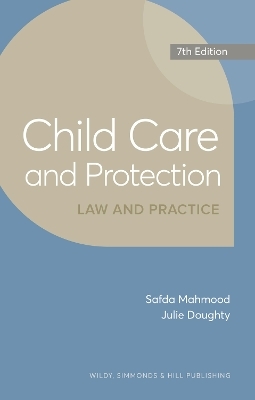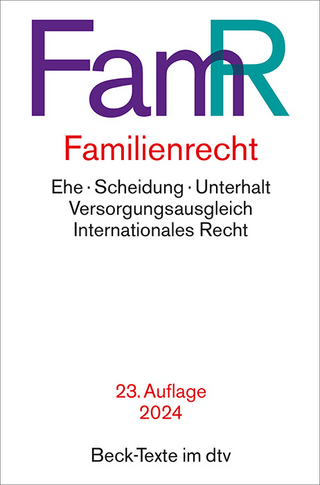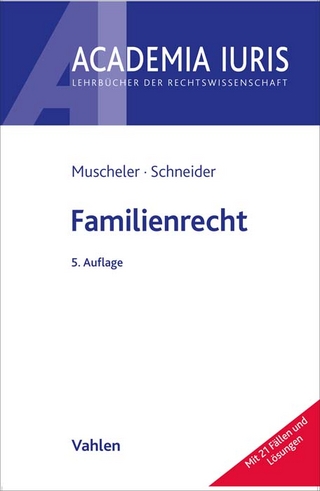
Child Care and Protection: Law and Practice
Wildy, Simmonds and Hill Publishing (Verlag)
978-0-85490-306-1 (ISBN)
the changes brought about by the Public Law Outline in January 2023 to family justice, particularly in relation to expert evidence, time limits, care plans and delay;
the law surrounding deprivation of liberty as it relates to children, regarding the interface between care proceedings and Article 5 ECHR, and consideration of key case law, such as Re T (A Child) [2021] UKSC 35;
the significant changes to instruction of experts, secure accommodation, child arrangements orders and private children law; significant secondary legislation and case law surrounding special guardianship orders, particularly with the implementation of the Special Guardianship (Wales) (Amendment) Regulations 2018;
the revision of Practice Directions, such as PD12A (Care and Supervision Proceedings and other Part 4 Proceedings: Guide to Case Management), Child Arrangements Programme (PD 12(B), and Revised PD12J – Domestic Abuse and Child Arrangements, Pilot Reporting and Private Law Review;
significant case law developments in children law since publication of the last edition; and
the revised edition of Working Together to Safeguard Children (2023), which has changed the position in relation to safeguarding and child death reviews, as well as assessments.
Safda has practised as a solicitor in both the private and the public sector. He is a solicitor, manager, and team leader in Advocacy with Coventry City Council, Legal Services Department. Safda runs training courses across England and Wales to members of the legal profession, and other professionals. Julie recently retired as a senior lecturer in law at Cardiff University School. She has written widely on children’s rights; adoption; and open justice. She has practice experience as a former solicitor and with Cafcass
Preface
Acknowledgements
List of Abbreviations
List of Figures and Tables
1 Glossary and Legislative Framework
1.1 Glossary of basic definitions
1.2 Orders available under the Children Act 1989
1.3 Introduction to the Children Act 1989
1.4 Changes to the Children Act 1989 introduced with the Family Court in 2014
2 Principles Underlying the Children Act 1989
2.1 Paramountcy of the welfare of the child
2.1.1 Welfare checklist
2.2 Delay is deemed prejudicial to child’s interests (the impact of the Public Law Outline)
2.3 No order unless necessary in the interests of
the child
3 Parental Responsibility
3.1 Definition, powers and duties of parental responsibility
3.1.1 Duration
3.1.2 Parental responsibility and medical consent
3.1.3 What if there is no one with parental responsibility?
3.2 Legal position of child’s birth mother
3.3 Legal position of child’s father
3.3.1 Married fathers and those who are civil partners
3.3.2 Unmarried fathers
3.4 Acquisition and loss of parental responsibility by child’s birth father
3.4.1 Parental responsibility order
3.4.2 Parental responsibility agreement with the mother
3.4.3 Joint registration of the birth by father and mother
3.4.4 Child arrangements order, specifying living with, and parental responsibility
3.5 Acquisition of parental responsibility by others
3.5.1 Relatives
3.5.2 Step-parents
3.5.3 Non-relatives
3.5.4 Guardianship
3.5.5 Special guardianship order
3.5.6 Parental responsibility, surrogacy and
the Human Fertilisation and Embryology Act 2008
3.5.7 Parental orders under section 54 of the Human Fertilisation and Embryology
Act 2008
3.6 Public funding in children cases
3.6.1 Public funding changes
4 Every Child Matters: Child Protection Procedures in Health and Social Work
4.1 Safeguarding partners, child safeguarding practice reviews, child practice reviews and child death review partners
4.1.1 Safeguarding partners and child safeguarding practice reviews
4.1.2 Child death review partners
4.1.3 Child practice reviews
4.2 Hierarchy within social services departments
4.3 Referral procedures and preliminary investigations
4.3.1 Involving the child
4.3.2 Involving families and information sharing
4.4 Child protection conferences
4.4.1 Purpose
4.4.2 Who should be invited to a child protection conference?
4.4.3 Documents
4.4.4 Decisions to be made and actions to be taken
4.4.5 Categories of abuse
4.4.6 Criteria for discontinuance of the child protection plan
4.5 Assessment of risk
4.6 Child protection plan
4.7 Child and Family Court Advisory Support Service
4.8 Local authority duty to promote welfare of children in its area
4.8.1 Duty to investigate potential or actual harm to child
4.8.2 Local authority duty to children in need
4.8.3 Services for children and their families
4.8.4 Duty to children aged under 5
4.8.5 Compliance with court order to investigate child’s circumstances, section 37 of the Children Act 1989
4.8.6 Looked after children: responsibility of the local authority
5 Emergency Protection Orders
5.1 Effects of order
5.2 Duration
5.3 Grounds for application
5.4 Practice and procedure
5.4.1 Application
5.4.2 Respondents
5.4.3 Applications made without notice (previously referred to as ex parte applications)
5.4.4 Notice
5.4.5 Service
5.4.6 Attendance
5.5 Contact, accommodation and the rights of the child
5.5.1 Contact
5.5.2 Accommodation
5.5.3 Rights of the child
5.6 Variation and discharge
5.7 Exclusion requirement under emergency protection order
5.7.1 Two notes of caution
5.8 How do ‘without notice’ orders and Article 6 of the ECHR fit together?
5.9 Emergency applications and newborn children
5.9.1 Out of hours emergency protection order applications
6 Child Assessment Orders
6.1 Effects of order
6.2 Grounds for application
6.3 Practice and procedure
6.3.1 Application
6.3.2 Venue
6.3.3 Respondents
6.3.4 Notice
6.3.5 Service
6.3.6 Generally
6.3.7 Discharge of order
6.4 Contact, accommodation and the rights of the child
6.4.1 Contact
6.4.2 Accommodation
6.4.3 Rights of the child
6.5 Appeals, variation and discharge
7 Care and Supervision Proceedings
7.1 Care order – definitions
7.2 Grounds for application for a care or supervision order
7.3 Significant harm
7.3.1 Standard of proof
7.3.2 Linking harm or likelihood of harm to the facts and test for separation
7.4 Practice and procedure
7.4.1 Applicants and public funding
7.4.2 Venue
7.4.3 Form
7.4.4 Respondents
7.4.5 Notice and court actions on issue
7.4.6 Service
7.4.7 Attendance
7.5 Interim orders
7.6 Effects of care order
7.6.1 Duration
7.6.2 Parental responsibility and care plans
7.6.3 Proportionality, kinship care and local authority accommodation of the child
7.6.4 Planning transition to adulthood
7.6.5 Contact with a child in care
7.6.6 Rights of the child in care proceedings and under a care order
7.6.7 Rights of parents of a child in care
7.7 Public Law Outline – principles, ‘fact-finding hearings’, issues resolution, interim and final hearings
7.7.1 Main principles of the Public Law Outline (Practice Direction 12A)
7.7.2 Various parts of Practice Direction 12A
7.7.3 Fact-finding hearings/split hearings
7.7.4 Practice Direction 12A checklists
7.8 Assessments and care planning
7.9 Effects of supervision order
7.9.1 Interim orders
7.9.2 Duration of care and supervision
7.9.3 Directions in supervision orders
7.9.4 Enforcement
7.9.5 Designated local authority
7.10 Removal of child from care
7.11 Variation, discharge and appeals
7.11.1 Variation and discharge
7.11.2 Appeals
7.12 Effects of the Human Rights Act 1998 on care and supervision proceedings
8 Secure Accommodation and Deprivation of Liberty Orders
8.1 Restricting liberty with a secure accommodation order
8.1.1 Safeguards
8.1.2 Criminal cases (secure orders)
8.1.3 Use of secure accommodation in civil cases
8.2 How long can a child be kept in secure accommodation?
8.2.1 Where no court order made
8.2.2 Secure order (child on remand in a criminal case)
8.2.3 Civil cases and children not on criminal remand – secure accommodation orders
8.2.4 Adjournments
8.3 Grounds for application
8.3.1 Children detained in criminal cases
8.3.2 Children in civil cases
8.3.3 Deprivation of liberty and secure accommodation
8.3.4 Welfare of the child and secure accommodation
8.4 Practice and procedure
8.4.1 Application
8.4.2 Forms
8.4.3 Venue
8.4.4 Respondents
8.4.5 Notice
8.4.6 Service8.5 Role of the children’s guardian
8.6 Contact
8.7 Rights of the child
8.7.1 Reviews
8.7.2 Attendance at court
8.7.3 Public funding
8.7.4 Right to legal advice
8.7.5 Age of child
8.8 Appeals and the Human Rights Act 1998
8.9 Deprivation of liberty orders
8.9.1 What constitutes a deprivation of liberty?
8.9.2 Applications for a deprivation of liberty order and the National DoL List
8.9.3 Use of the inherent jurisdiction and position surrounding the child’s consent
8.9.4 Court of Protection and deprivation of liberty applications
8.9.5 Shortage of placements and ongoing difficulties
8.9.6 Deprivation of liberty orders and enforceability in Scotland
8.9.7 Unregistered placements and supported placements
9 Education Supervision Orders
9.1 Effects of an education supervision order
9.2 Duration
9.3 Grounds for application
9.4 Practice and procedure
9.4.1 Application
9.4.2 Venue
9.4.3 Notice
9.4.4 Respondents
9.4.5 Service
9.5 Rights of the child
9.6 Variation, discharge and appeals
9.6.1 Appeals
10 Police Powers under the Children Act 1989
10.1 Police powers and responsibilities
10.2 Contact with child
11 Instructions and Case Preparation in Family Proceedings
11.1 Action plan on receipt of instructions from an adult or local authority
11.2 Interviewing clients
11.2.1 Checklist for information from parents
11.2.2 Checklist for Public Law Outline requirements on information from local authorities and social workers
11.2.3 Checklist for basic initial information from medical witnesses
11.2.4 Working with parents with a learning disability and participation directions
11.3 Preparation of the case
11.4 Burden of proof and standard of proof in child law cases
11.5 Special evidence rules in child law cases
11.5.1 Character
11.5.2 Best evidence and hearsay
11.5.3 Opinion
11.5.4 Statements made by children’s guardians
11.5.5 No professional privilege for medical or psychiatric reports
11.5.6 Case management hearings – ordering the evidence
11.6 Court procedure at the hearing
11.6.1 Notes of evidence
11.6.2 Order of evidence
11.6.3 Extent of evidence
11.6.4 Case management hearing/issues resolution hearing: key checklist matters for advocate to consider
11.7 Courtroom skills
11.7.1 Court manners
11.8 Transparency
11.8.1 Media attendance and reporting hearings
11.8.2 Objections to attendance
12 Children’s Rights
12.1 To accept or refuse medical treatment
12.1.1 Children aged over 16 (but under 18)
12.1.2 Children aged under 16
12.1.3 Children who lack capacity to make a decision
12.1.4 Where no available person has parental responsibility
12.2 To accept or refuse medical or psychiatric assessment
12.2.1 Circumstances in which the court may direct medical or psychiatric examination or assessment which the child has a right to refuse
12.3 To make his or her own application to the court
12.4 To request confidentiality and, in the event of disagreement with the children’s guardian, to instruct a solicitor separately
12.5 Rights of a child in care
12.6 UN Convention on the Rights of the Child
13 Other Orders available to the Court in Family Proceedings
13.1 Orders in family proceedings
13.2 Section 8 orders
13.2.1 Leave to apply
13.2.2 Considerations on application for leave
13.2.3 Duration
13.2.4 When the court may not make an order under section 8 of the Children Act 1989
13.2.5 Welfare reports in applications under section 8 of the Children Act 1989
13.3 Contact (spending time with, or otherwise having contact with)
13.3.1 Contact disputes
13.3.2 Activity orders
13.4 Prohibited steps
13.5 Residence (living with)
13.5.1 Residence and parental responsibility
13.6 Specific issue
13.7 Supplementary provisions
13.8 Practice and procedure in applications under section 8 of the Children Act 1989
13.8.1 Mediation Information and Assessment Meetings and non-court dispute resolution
13.8.2 Applications
13.8.3 Venue
13.8.4 Notice of application for orders under section 8 of the Children Act 1989
13.8.5 Respondents
13.8.6 Service
13.8.7 Applications made without notice (formerly known as ex parte procedures)
13.8.8 Withdrawal, variation, discharge and appeals
13.9 Family assistance order
14 Commencement and Transfer of Proceedings
14.1 General rules
14.2 Applicants and allocation of family case
14.2.1 Proceedings which must be commenced in the Family Division of the High Court
14.2.2 Proceedings which must be commenced in the Family Court
14.3 Transfers
14.4 Urgent applications
15 Working with Children
15.1 Appointment and role of the children’s guardian
15.1.1 Official Solicitor
15.1.2 Public funding, access to information and disclosure
15.1.3 Specified proceedings
15.2 Conflict between children’s guardian and child
15.2.1 Confidentiality
15.3 Should I see my child client?
15.3.1 Meeting a child client
15.3.2 Decisions concerning a child’s competence
15.4 Taking instructions and communicating with children
15.4.1 Guidelines on effective meetings and communication with children
15.5 Child development
15.6 Understanding your child client – race, religion, culture and ethnicity
15.7 After the case is over
15.8 Judges seeing children in children law proceedings
16 Assessment of Children in Need and Care Planning
16.1 Developments and materials
16.1.2 Resources for professionals
16.2 Assessment Framework
16.3 Care planning
16.4 Adoption issues
16.4.1 Legislation and other materials
16.4.2 Independent Review Mechanism
16.4.3 Publications
17 Appeals and Enforcement
17.1 Appeals and judicial review
17.1.1 Appeal process and when permission is required
17.1.2 Time limits for notice and procedure
17.1.3 If permission is refused
17.1.4 When will permission be granted?
17.1.5 Judge sitting in Family Court appeals
17.1.6 Lay justices/magistrates appeals
17.1.7 Circuit judge or recorder appeals
17.1.8 Judge of High Court Judge level appeals
17.2 Complaints procedures
17.3 Enforcement
18 Expert Evidence
18.1 What is an expert witness?
18.2 Choosing and instructing expert witnesses
18.2.1 Funding issues and prior authority from the Legal Aid Agency to instruct expert witnesses
18.3 Expert witness evidence
18.3.1 Expert instruction checklist
18.4 Expert evidence in court
18.5 Finding the right expert
18.5.1 Registers and directories
18.5.2 Online resources
19 Improving Law, Skills and Practice
19.1 Professional and interdisciplinary associations
19.2 The Law Society’s Children Law Accreditation
19.3 Sources of useful information and contacts for children and families, and those who work with them
| Erscheinungsdatum | 03.09.2024 |
|---|---|
| Verlagsort | London |
| Sprache | englisch |
| Maße | 138 x 216 mm |
| Gewicht | 406 g |
| Themenwelt | Recht / Steuern ► EU / Internationales Recht |
| Recht / Steuern ► Privatrecht / Bürgerliches Recht ► Familienrecht | |
| Sozialwissenschaften ► Pädagogik ► Sozialpädagogik | |
| Sozialwissenschaften ► Soziologie | |
| ISBN-10 | 0-85490-306-2 / 0854903062 |
| ISBN-13 | 978-0-85490-306-1 / 9780854903061 |
| Zustand | Neuware |
| Informationen gemäß Produktsicherheitsverordnung (GPSR) | |
| Haben Sie eine Frage zum Produkt? |
aus dem Bereich


